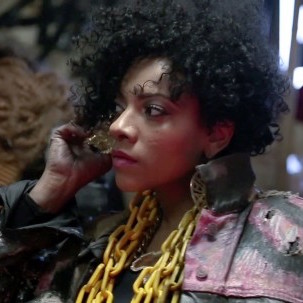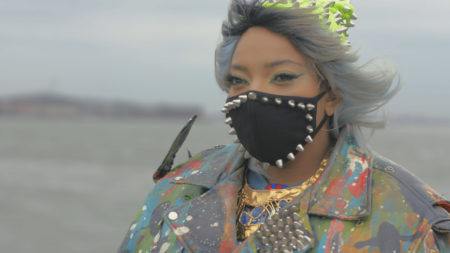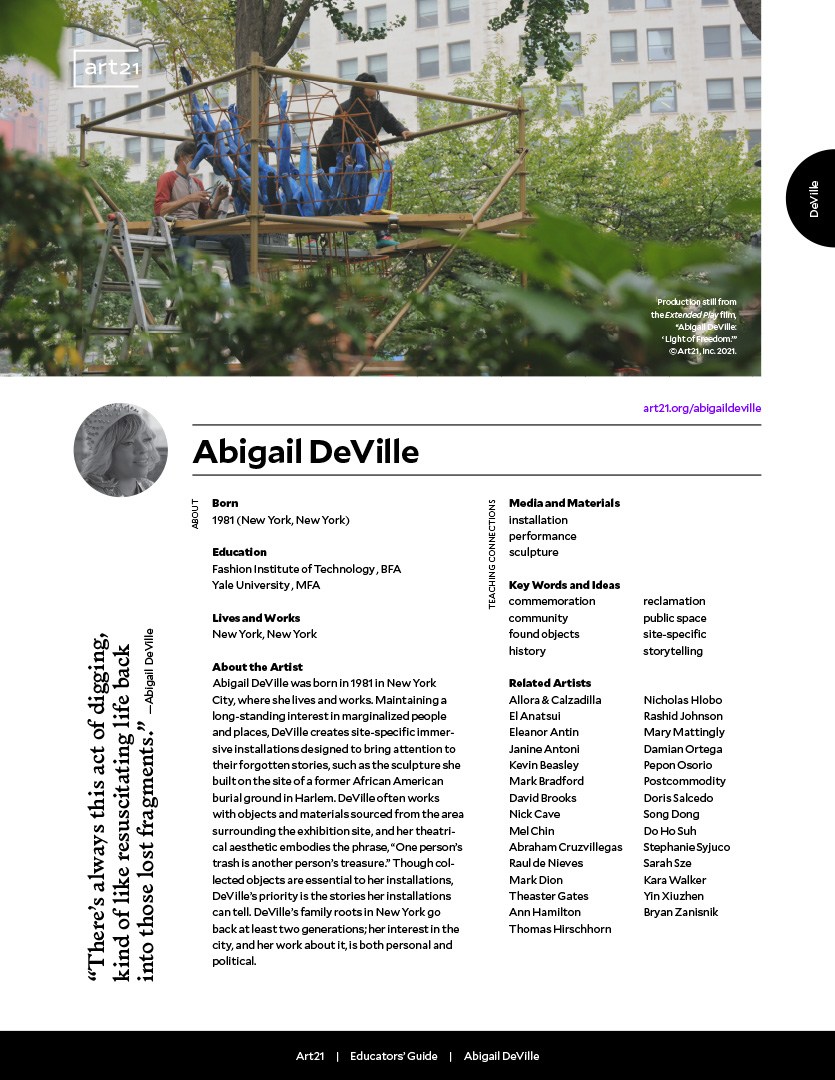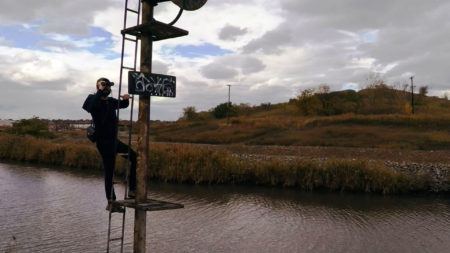Continue playing
(Time remaining: )
Play from beginning
Continue playing "{{ controller.videos[controller.getVideo(controller.currentVideo)].segmentParentTitle}}"
{{controller.videos[controller.getVideo(controller.currentVideo)].title}} has ended.
Abigail DeVille's Harlem Stories
How does an artist acknowledge forgotten people? In this film, artist Abigail DeVille stalks the streets of Harlem with a trash-laden push cart, creating temporary sculptural interventions along the way. Stopping at Lenox Avenue and 131st Street, Bronx-born DeVille tucks a smiling plaster cast of her face into an outdoor planter. It’s the site of her grandfather’s childhood home, a former brownstone converted into a conspicuous eyesore of an apartment building. DeVille explains that placing the sculpture there is an act of personal and historical reclamation, a way of acknowledging “groups of people that occupied a space that no longer exists…but helped shape the space into what it is now.” Over Super 8mm film footage of contemporary Harlem, DeVille describes a landscape under the constant pressure of development and gentrification.
“It feels like the earth is shifting,” she says, “New groups of people are moving in and old groups of people are being pushed out. So it’s almost like migratory patterns of birds.” Pushing her unwieldy cart to the East River no man’s land at the base of the Willis Avenue Bridge, DeVille unloads heaps of distressed wood, rusty metal, mannequin heads, and trash bags. This unkempt and unceremonious site is the presumed location of a pre-colonial African burial ground where free and enslaved families buried their dead when Dutch settlers farmed upper Manhattan, dating back to the seventeenth century. DeVille characterizes her sculpture as “an exercise in acknowledgment” and asserts that trash is the ideal material for talking about a forgotten history “because that’s how those people were treated. That’s how that site is being treated.”
Featuring DeVille’s artwork Harlem River Blues (2014).
Credits
Art21 New York Close Up Created & Produced by: Wesley Miller & Nick Ravich. Editor: Erin Casper. Cinematography: Ian Forster, John Marton, & Nick Ravich. Sound: Wesley Miller & Nick Ravich. Design & Graphics: CRUX Design & Open. Artwork: Abigail DeVille. Thanks: Steve Cossman, Antonio DeVille, Elizabeth Gwinn, Sean Hanley, Amanda Long, MONO NO AWARE, PAC LAB & Studio Museum in Harlem. An Art21 Workshop Production. © Art21, Inc. 2014. All rights reserved.
Art21 New York Close Up is supported, in part, by The Lambent Foundation; the New York City Department of Cultural Affairs in partnership with the City Council; The Andy Warhol Foundation for the Visual Arts; and by individual contributors.
Closed captionsAvailable in English, German, Romanian, Italian, Japanese, Korean, Chinese, Italian
Through the Art21 Translation Project, multilingual audiences from around the globe can contribute translations, making Art21 films more accessible worldwide. Translate this video now.
Interested in showing this film in an exhibition or public screening? To license this video please visit Licensing & Reproduction.
Abigail DeVille was born in 1981 in New York, where she lives and works. Maintaining a long-standing interest in marginalized people and places, DeVille creates site-specific immersive installations designed to bring attention to these forgotten stories. DeVille often works with objects and materials sourced from the area surrounding the exhibition site. Though collected objects are essential to her installations, DeVille’s priority is the stories her installations can tell. DeVille’s family roots in New York go back at least two generations; her interest in the city, and her work about it, is both personal and political.
“It feels like the the earth is shifting.
New groups of people are moving in and old groups of people are being pushed out. So it’s almost like migratory patterns of birds.”
Abigail DeVille
Abigail DeVille
Abigail DeVille
Educators' Guide: Abigail DeVille
The questions and activities included in this guide are recommendations for incorporating Art21 films featuring Abigail DeVille into your classroom.








